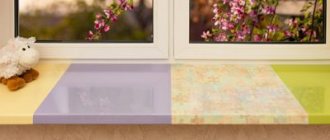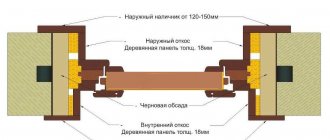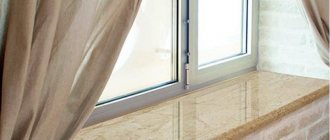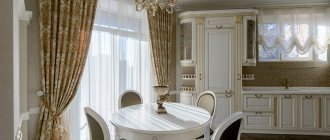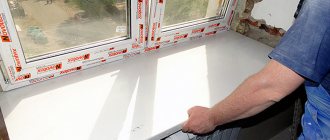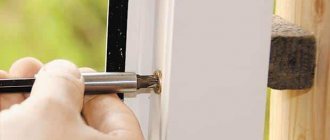When installing window structures in houses, apartments or public spaces, it is necessary to decide in advance on the selection of window sills. To know exactly which one to choose for plastic windows and not make a mistake, let’s consider this issue in more detail: types, types, colors, shape, sizes and components.
The window sill is an integral part of the integrity of the window opening. It completely covers all joints after installation, protects against drafts, and gives the window a finished look and beautiful design. If desired, it can be made with an extension (expanded) to be used not only for placing flowers or other items, but as a small table. Manufacturers offer a wide selection of window sills.
Types of window sills for plastic windows
Window sill options are available to suit every taste, with a wide variety of materials to choose from. Let's look at the most common configurations of these products.
Plastic window sills
PVC window sills for plastic windows are not inferior in quality to models made from other materials, although they are cheaper.
The PFC profile (walls with a thickness of 3 mm or more) is internally divided into several chambers and has vertical and diagonal stiffening ribs (from 1.5 mm). Thanks to this, the material has good strength and heat capacity. The standard sizes are as follows: board thickness 20 mm, width 50–600 mm (50 mm increments) and 600–1000 mm (100 mm increments). Before work, measure the width of the opening in the window and add 5–10 cm; the resulting result is rounded to the nearest standard size. Advantages of the material:
- resistant to moisture and aggressive chemicals;
- has the lowest prices of all existing materials;
- installation is simple;
- heat-saving, no shrinkage;
- a large selection of palettes and texture imitations;
- it is possible to apply compositions that increase strength.
The disadvantages include:
- short service life;
- does not tolerate high temperatures - you can’t put it too hot, there will be stains;
- In case of mechanical damage and cracks from impacts, the module will have to be replaced.
Plastic material does not absorb unpleasant odors, dirt is easy to clean.
Wooden structures
Wooden window sills are perfect for plastic windows. Especially if the latter are made with imitation wood. Pine or spruce, oak, ash or beech are widely used for this. The thickness of the wooden board for the window sill is from 40 mm, the width is 100–1,500 mm, the length is 300–4,000 mm.
Advantages:
- the tree looks noble and impressive;
- durable and environmentally friendly material;
- wooden window sills can be coated with wax, transparent varnish or with imitation of valuable species.
Disadvantages of the material:
- high prices;
- Do not put it hot;
- wood may crack or bend;
- requires good care.
Wooden window sills for plastic windows can be made not only from solid wood, but also from chipboard (adhesive pressing of shavings, sawdust) or MDF (the same thing, but the adhesive composition is replaced with paraffin, lignin). Chipboard is not a hydrophobic material, has high insulating qualities, no deformation from moisture, and has a low price. It is made in the form of slabs, which can subsequently be cut into pieces of any length. MDF differs from chipboard in its 2 times increased strength. The characteristics are similar, but MDF has a wider range of different coatings and can withstand cleaning well. The width of the models can be up to 1,000 mm, and the length more than 2,000 mm.
Composite window sills
The variety of window sills for plastic windows is complemented by composite products. They usually combine two different materials. MDF and chipboard or WPC are often used as a basis. The covering can be made of natural wood veneer (0.6 mm thick) or vinyl film. The length of the product is up to a maximum of 2,400 mm, and the width is 850, 1,000 mm.
Product advantages:
- low prices compared to natural materials;
- simple installation;
- large selection of colors and textures;
- easy care - cleaning a window sill made of composite materials is not difficult.
The material has disadvantages:
- not recommended for installation in rooms with constant humidity - bathrooms, kitchens, swimming pools;
- upon impact, the integrity of the coating may be damaged.
If composite materials are used for their intended purpose, they will last a long time.
Stone (artificial and natural)
The window sill material can be chosen from stone, both real and artificial. This material is expensive, especially natural stone, but durability is guaranteed for many years.
A stone model can serve as an excellent tabletop, the advantages are obvious:
- strength and status;
- you can put it hot;
- is not a medium for the development of bacteria;
- moisture and temperature changes are not scary.
The disadvantage is:
- high price;
- possible scratches and chips are noticeable on the surface - they need to be covered up;
- complexity of installation.
To hold heavy stone modules, heavy-duty fasteners are needed.
PVC windows and artificial stone window sills are a very popular choice in recent years. Artificial stone is made from fine granite or marble with the addition of acrylic binders and hardeners with pigments. It is practically not inferior to a natural product in terms of hardness. But the likelihood of chipping is much lower.
Quartz stones have a polyester resin as their binder, and the base is quartz (ground). This option provides a varied palette of shades thanks to the use of mineral pigments. The material is heavier than acrylic products, but is more susceptible to chipping.
Concrete and poured structures
One of the types of window sills for plastic windows is concrete, self-leveling. He is well known to many. In houses of old buildings, such options were often installed; this can be seen in numerous photographs of that time. This option can be updated by carrying out cosmetic repairs. New models made from this material resemble artificial stone in appearance and have decor in the form of pigment or inclusions. It is worth choosing a concrete window sill for installation in public places: clinics, hospitals, institutions. Liquids as decoration include colored stones, pieces of mirror, glass, 3D technology is available - suitable for the home as exclusive options.
Advantages of the material:
- strength;
- aesthetic appearance;
- acceptable prices;
- smooth surfaces;
- resistance to mechanical stress.
The disadvantage is installation, which is preferably carried out only by specialists due to the heavy structure
Additional attention needs to be paid to
Labeling and quality certificates are not the only things you need to pay attention to when purchasing window sills. When purchasing these products, it is recommended:
- Give preference to products from time-tested brands;
- Make sure there is a protective film;
- Obtain from the seller information about the manufacturer’s warranty obligations;
- Check the number of stiffeners - it is advisable that the distance between them does not exceed 35 mm;
- Find out the maximum load that the product can withstand.
If window sills are ordered together with windows, then all this information must be obtained from the manager, and then checked when delivering the products to the site.
The minimum thickness of the top wall of a plastic window sill should be 3 mm, the vertical stiffeners - 1.5 mm, and the bottom wall - 2 mm.
Accessories for window sills
You can install the structure yourself, having previously prepared all the necessary components:
- End caps - decoration for the ends of the window sill.
- Connectors - used to join structural elements at an angle.
- Slopes are the perimeter inside the window from the frame to the wall surface. When replacing an old structure, they often have to be restored from deformation.
- Brackets – necessary when strengthening heavy weights.
If you plan to place heavy objects on the windowsill of a plastic window, or use it as a “sofa,” then you should additionally install strong fasteners inside under the structure or choose a high-strength window sill block.
When using components and fasteners to install a window sill according to the instructions, step by step, problems usually do not arise.
Varieties of window sill design
There are numerous types of window sill designs for plastic windows - from classic and standard to exclusive options. Among them the most interesting:
- Curly - a design that can be of any complex shape, for the most non-standard window. All kinds of monograms, bends and curls are easy to do.
- Original design solutions with the raw edge of a wooden board - a natural, uneven edge. An ideal solution for decorating a country house or cottage.
- Arc-shaped - have become popular in connection with the construction of new residential complexes, where window structures in the form of a semicircle are used.
- Bay windows - also used on rounded windows, but have corners at the joints.
The structure can always be expanded if desired, if the thickness of the wall allows. Then it can be used as a table for work or tea.
The sizes of the window sills can be adjusted for maximum convenience. But we must remember that the width limitation is the protrusion from the cornice wall to the curtain - the distance from the window sill to the curtain is 2 cm. The radiator with the extension of the window sill should be closed by no more than half. The heated air from the battery should circulate freely upward.
How to choose a color?
The easiest way to decide on the color of the window sill is to look at the window. Since the frame will be the closest piece, it is logical to make both parts the same color. Example: a white plastic window with a snow-white PVC window sill.
At the same time, color is more important than material - that is, a MDF or acrylic board would be suitable for white PVC windows - why not? Moreover, the last two have much wider possibilities for decorating and adjusting the shape.
Another option is a combination with slopes. That is, the window can be white, and the slopes around the perimeter and the horizontal slab can be gray, beige, black. The appearance of such an assembled structure resembles a portal and actively attracts attention - an excellent way to decorate a window without using curtains.
Don’t forget about the radiator: if you are going to cover it with a grille, make a solid composition with a window sill - it will look harmonious. The best option for finishing in this case is wood.
The photo shows a plywood window sill
On the other hand, you don’t have to match it with something: you can focus on it. For example, a wooden covering combined with a white window. Or white paired with black.
The location of the window also has its influence on the choice of colors: in a kitchen or bedroom, for example, a window sill can serve as a table and it is logical to make it match the rest of the furniture in the room.
Color solutions for window sills
Depending on the interior, the color of the product can be any.
Plastic models are available in the following shades:
- classic white color;
- marbled;
- under the tree;
- assorted colors.
Colored window sills for plastic windows made of wood vary in tone and type of wood. The color changes with the use of waxes, varnishes or oils.
The surfaces of chipboard, MDF and composite models have a rich palette of colors - from white to dark brown shades. Window sills for plastic windows made of natural stone can be purchased from light, cream, gray to dark chocolate tones. Artificial stone has a very wide selection of different color compositions. Concrete and poured models can be in white, beige, gray and melange tones.
Made from natural stone
Granite, marble or onyx are used for natural stone window sills. Such slabs are well polished, have a beautiful texture and intricate pattern. But due to difficulties in production (possible internal voids in the stone), they are not cheap (up to 4,000 rubles / linear meter with a sheet thickness of 20–30 mm).
Window sills made of natural stone are not resistant to surface damage: they are easily scratched. And deep scratches that stand out on the stone are extremely difficult to remove. To transport and install the stove you will need 2-4 people.
Window sill surface types
The surfaces of window sills for plastic windows are of two types - matte and glossy, their differences are:
- It is advisable to choose window sills and slopes from the same material (without mixing gloss with matte texture).
- The mirrored glossy surface adds light to the room by reflecting it. Numerous highlights emphasize purity and shine. The matte texture looks simple and neat.
- Appearance. Dirt, mechanical damage, and scratches are immediately visible on the glossy mirror surface, but on a matte surface all this is invisible.
- It is easier to wash window sills with a glossy texture. The rough surface of a matte finish is more difficult to clean and is prone to dust accumulation. In addition, sunlight contributes to the fading of this surface.
If the window is located on the north side and does not need to be washed daily, then the matte option is suitable. If the installation is in the kitchen and on the sunny side - gloss.
Main criteria and parameters
We need to pay attention to:
- availability of certificates;
- compliance of the product design with GOST requirements;
- characteristics of the material from which the board is made;
- coating and impregnation;
- matching the characteristics and colors of the window structure;
- a list of care products for a specific window sill;
- rules for using the product;
- resistance to loads;
- price;
- appearance;
- warranty period provided by the manufacturer;
- Possibility of service at a service center or at the manufacturer.
Important! All information must be obtained before purchasing a window sill board.
Window sill manufacturers
Moeller
Window sill Moeller (Müller) is German quality, affordable prices. The basis of the composite material is a wood-plastic mixture, and this is a new generation of products. This brand leads in the quality of multilayer laminate and heavy-duty glue. The models are an alternative to marble and granite products.
The advantages are as follows:
- structural rigidity;
- excellent look, many shades;
- high resistance to damage, high temperatures, humidity;
- fire safety;
- high-quality raw materials, environmental safety.
The model is easy to install and has a long service life.
Elex (Elex)
The Elex window sill from a Russian manufacturer is widely known in the country. The production of products from the best raw materials using European equipment allows us to achieve high quality. A special technology allows us to obtain a finished monolithic product without joints or seams.
Advantages of the models:
- high-quality surface – special film protects from moisture, damage, temperatures;
- color fastness - does not fade in the sun;
- resistance to chemicals - you can use detergents;
- environmental friendliness, fire safety;
- strength – stiffening ribs, inclined and triangular planes, allow them to withstand significant loads.
The product has a long service life and installation is simple.
Danke
The Danke window sill from German manufacturers will provide high quality and excellent design. The original arrangement of the stiffening ribs provides increased strength for a long time. Ultra-durable glossy finish protects against damage.
The advantages of the model are as follows:
- the monolithic surface does not fade over time;
- multilayer coating structure;
- resistance to high temperatures;
- environmentally friendly.
Products are offered with imitation marble, wood and other materials.
Vitrage
The Vitrage window sill meets all modern standards. Vertical stiffening ribs guarantee strength, and the coating protects against damage.
Product advantages:
- service life up to 40 years;
- five-component laminate with high wear resistance;
- the surface does not fade, is moisture resistant;
- environmental friendliness.
The models are simply mounted.
Crystallit
The Crystallit window sill has a beautiful modern look, a model range with a woody, light design and a glossy surface. The models are antistatic - they do not attract dust.
Advantages of Crystallit:
- huge service life - up to 50 years;
- resistance to moisture, abrasion;
- UV resistance;
- environmental friendliness;
- can be washed with detergents.
A multi-layer coating of acrylic resins gives the product excellent strength.
Werzalit
Window sill Werzalit (Werzalit) is German quality, unique manufacturing technologies. The product is based on polymer resins and crushed wood, which are pressed under high pressure and temperature. The monolithic window sill of this brand is the only one in the segment of plastic models that is completely filled from the inside.
Other advantages of the product:
- large selection of colors, shapes, sizes;
- durability - all original properties are preserved for decades;
- environmental friendliness;
- easy care.
The material does not absorb dirt, installation of the structure is not difficult.
Montblanc (Mont Blanc)
The Montblanc window sill is produced using German technology and has an original design of stiffening ribs. This gives the model high strength. The unique coating enhances protection against damage, gives an aesthetic appearance and durability.
Product advantages:
- fire safety, environmental friendliness;
- moisture resistance – can be used in rooms with high humidity;
- rot resistance;
- color fastness.
The material is unpretentious and easy to care for.
FiberSill (Fabersil)
The FiberSill window sill (Fabersil) has two capinos, one of them can be sawed off. High-strength coating is resistant to mechanical damage.
Pros of the model:
- moisture resistance;
- Beautiful design;
- resistance to high temperatures;
- environmental friendliness, fire safety.
Installation is simple, maintenance is easy.
Window sill care
In order for a window sill to serve for many years, it must be properly cared for. Different materials require different care:
- PVC is an unpretentious material, but there are some nuances in care. Glossy models can be easily scratched, so it is not recommended to move anything on this surface. Matte surfaces become clogged with dust and must be wiped 1-2 times a week. Very hot objects (over 110 0C) can damage the surface. To clean the window sill of plastic windows from dirt, you cannot use hard sponges or abrasive powders - they scratch the coating. Aggressive cleaning agents provoke the destruction of the protective layer. It is recommended to clean the window sill with a soap solution or window liquid. And, to wash it from yellowness, you can liberally apply a soap solution to the surface and leave for 20 minutes.
- Stone - care with acid and alkaline chemicals is not allowed. Scratches and chips are repaired with special resins. Non-aggressive detergents, soap and soft sponges or rags are recommended.
- The tree requires special care. Do not leave the surface wet and do not use hard sponges. For washing, use soft flannel or napkins. After a certain period of time, it is recommended to treat the wooden surface with impregnations and wax.
- Combined materials can easily withstand high temperatures up to 1800C. They do not absorb grease, coffee, tea, wine, so they are easy to wash; if traces of varnish or marker are left, acetone will remove all stains without harming the coating.
The easiest way to care for concrete window sills. They are resistant to various detergents and sponges.
Wooden
Beautiful window sills made from solid dried wood indicate the good taste of the owner. They are made from:
- pine, larch (price – 2500–2800 rub./m²);
- oak, ash, beech (price - from 4500 rub./m² with a blade thickness of 40 mm);
- elite species (black, mahogany).
The solid array can be replaced with separate beams, tightly glued together.
But such products require regular maintenance. Before making window sills, the array is impregnated with an antiseptic to prevent destruction. The texture and color of natural wood are preserved thanks to a layer of oil (mastic, varnish). And this surface layer needs to be updated (once every 1–1.5 years).
On sale you can find wooden window sills with the following dimensions:
- The length of the canvas is from 15 cm, width – up to 1 m.
- The length of the canvas is from 70 cm, width – up to 3 m.

